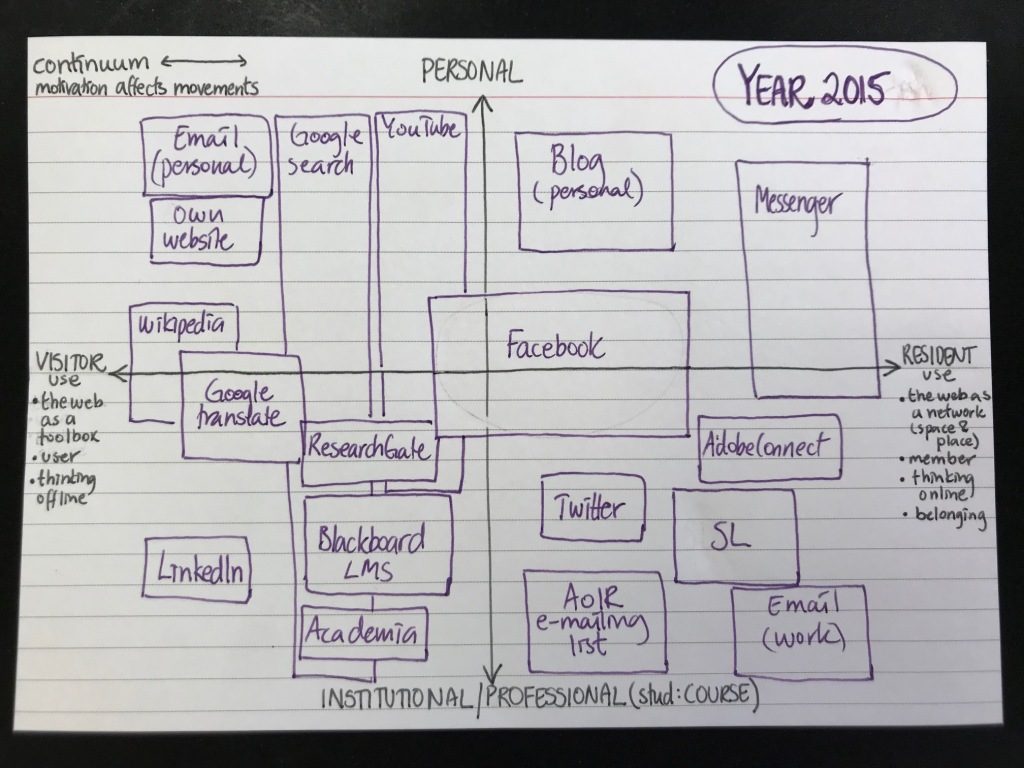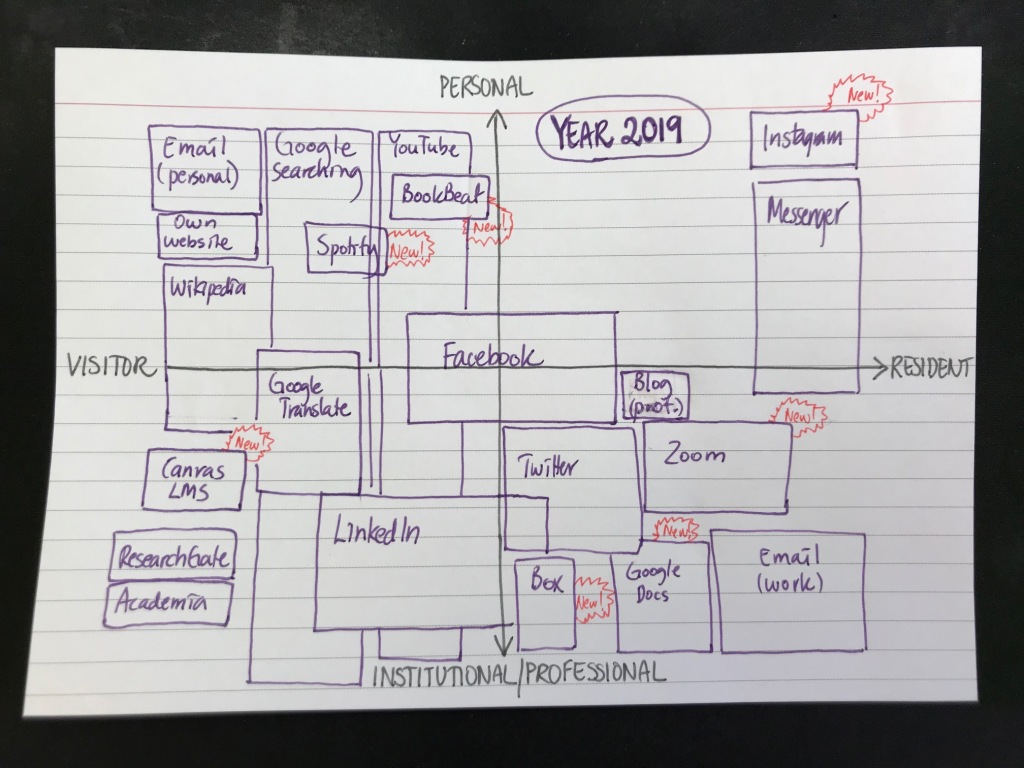In this blog post, I will discuss who I am in the digital era and what have characterized my journey this far. I will do this by comparing my current state with how it looked like for five years ago, utilising the visitor-resident model.
I have been living online for many years, having a presence e.g. on Facebook since 2007, LinkedIn since 2010 and Twitter since 2011. This has probably to do with my background as an instructional designer. I have a clear memory from my very first course at the university, studying for my bachelor’s degree and becoming an instructional designer. It was late in the evening and I was deep down in my course readings. Among other things, we read Sherry Turkle’s Life on the screen: Identity in the age of the internet (1995) which dealt with questions of how living online makes us re-evaluating our identity. Since that course, I am every now and then reflecting on the relationship between online and offline presence and how they could be viewed as merging, spilling over into each other, but are also kept apart (Bolldén, 2015; Sundén, 2007, 2009). Regardless of how you see the relationship, I think Suchman (2007) describes it well when she contends that figures of human are materialized in technology, or Mol (2002) who speaks about a body multiple. In a digital era, we actively produce ourselves in online-offline settings, whether deliberately or unintentionally. Even if you do not produce yourself in a certain setting (e.g. in a social network on a certain platform) that is also a choice.
In order to make my journey and digital engagements visible, I have utilized the visitor-resident model (White & Le Cornu, 2011). This is how my map looked like in 2015:
 Visitor-resident map 2015
Visitor-resident map 2015
About five years later, it looks like this:
 Visitor-resident map 2019
Visitor-resident map 2019
Can you see any differences? At first glance, perhaps the most visible is that new platforms have emerged (such as Spotify, BookBeat, Instagram, Zoom, Canvas, GoogleDocs and Box). One could ask if this is only a matter of digital development. I am inclined to say no. Of course, it has to do with new products on the market (which invites me to not only read books but also listen to them when being at the gym). But it also has to do with a shift of university and profession – from researcher to educational developer. When carrying out my research platforms like Adobe Connect, Second Life and the emailing list of the association of internet researchers were central. Today, platforms like Zoom, Twitter, Box and GoogleDocs are more central to the current profession.
Another difference is that my digital residency has increased in my professional practice (lower right corner). This has caused a digital fatigue in my personal residency. In other words, I find myself to be less residential online for personal purposes and expands my top left quadrant more and more. Another reason for the growing hollowness in the top right quadrant is the experience of becoming a more public person, due to both the professional practice but also moving to a smaller city. The debate on privacy issues on social networks such as Facebook contributes as well. During the last couple of years, I have observed new behaviours, such as restricting access to my spaces on platforms located in the top right hand corner, googling myself on a regular basis and being more careful to what I am signing up for when entering new platforms. Is this development good or not? I am not entirely sure. But in line with Turkle (1995) I am re-evaluating my identity when observing myself materialised in technology, and carries out a daily struggle of handling my personal-professional body multiple (Mol, 2002). What I can see when watching my journey in retrospective, I see that I am thriving in the digital age by pruning my life online. Pruning because of the shortcomings of the platforms’ ability in handling my data with care, pruning because of new technical developments (new platforms), pruning because of the total amount of time I want to spend online – regardless if it is for personal or professional purposes (I want to spend time with my family, being outdoors, meeting colleagues both online and offline). To summarise: I have come to a state where I need to prune in order to thrive.
References
Bolldén, K. (2015). Online teaching practices: Sociomaterial matters in higher education settings (Doctoral thesis, Linköping University, Linköping, Sweden).
Mol, A. (2002). The body multiple: Ontology in medical practice (2nd printing 2005). Durham: Duke University Press.
Suchman, L. A. (2007). Human-machine reconfigurations: Plans and situated actions (2nd ed.). Cambridge: Cambridge University Press.
Sundén, J. (2007). On cyberfeminist intersectionality. In M. Sveningsson Elm & J. Sundén (Eds.), Cyberfeminism in northern lights: Digital media and gender in a Nordic context (pp. 30–50). Newcastle: Cambridge Scholars Publishing.
Sundén, J. (2009). Double life on the screen. In A. N. Markham & N. K. Baym (Eds.), Internet inquiry: Conversations about method (pp. 119– 123). Los Angeles: Sage
Turkle, S. (1995). Life on the screen: Identity in the age of the internet. New York: Simon and Schuster.
White, D. & Le Cornu, A. (2011). Visitors and residents: A new typology for online engagement. First Monday, 16(9)